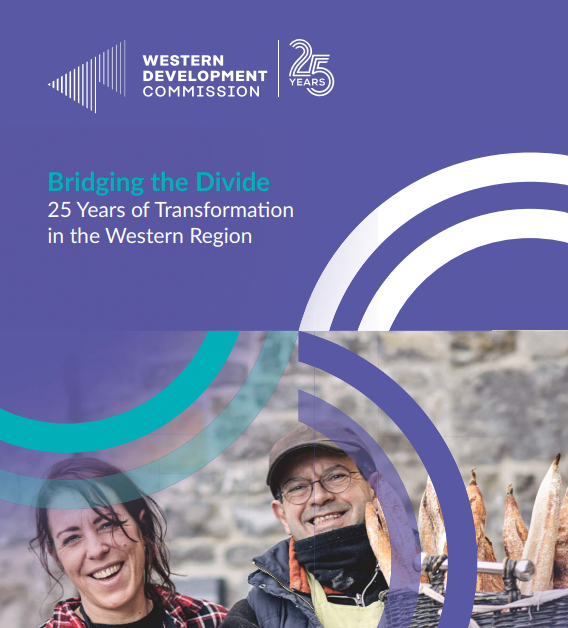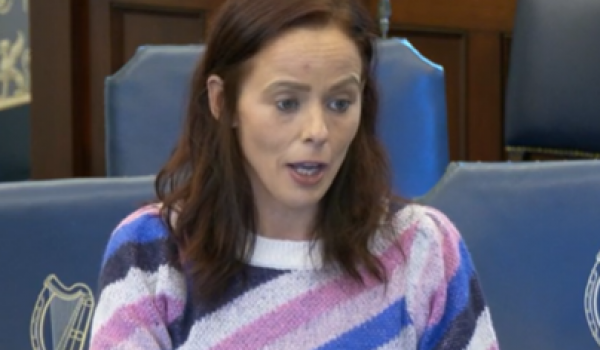
The Western Development Commission has marked its 25th anniversary with the publication this morning of a report assessing where it has succeeded in its objectives, but also examining what remains to be achieved, and where it needs to improve.
The report, which was produced independently, acknowledges notable successes, such as job creation, economic growth, and enhanced third-level educational provision.
However, it also sheds light on persistent gaps in income, housing, and rural infrastructure.
CEO Allan Mulrooney says the region is at a tipping point, and WDC will continue to advocate for better infrastructure and more investment:
Release in full –
Release in full –
Marking 25 years of driving balanced growth in Ireland’s Western Region, the Western Development Commission (WDC) has unveiled a landmark report highlighting the region’s remarkable progress and the critical challenges still facing the West and Northwest.
The report, commissioned by the WDC and prepared by Indecon, Ireland’s leading independent economic research and consultancy group, and the WDC, highlights notable successes, such as job creation, economic growth, and enhanced third-level educational provision. It also sheds light on persistent gaps in income, housing, and rural infrastructure.
Speaking on the findings, Allan Mulrooney CEO of the WDC said: “While we’ve achieved a lot in the last 25 years, the Western and Northwestern Region is at a tipping point. Our report shows that with strategic investment and collaboration, we can build on this foundation to create an even more prosperous and sustainable future for the area.”
Economic Growth Amid Income Disparities
The WDC has played a pivotal role in boosting the region’s economy, helping companies generate over €3.35 billion in cumulative revenue and €2.4 billion in exports since its inception. Companies supported by the State Agency contributed €404 million in tax revenues, providing much-needed support for public services. When wider (indirect and induced) impacts are included, the economy-wide output impact of the WDC is estimated to be almost €4.8 billion.
However, despite these successes, the report reveals a stark economic disparity, with the average disposable income in the Western Region remaining just over €3,000 below the national average.
Mulrooney continued; “This income gap shows that while the region has come far, we need targeted investment in high-value areas like infrastructure, connectivity, and renewable energy to ensure long-term prosperity for the region.”
Gross Value Added (GVA) per capita in the West is only 53.37% of the national average (€43,540 vs. €81,573), and for the Border Region, it is even lower at 29.7% of the national average (€24,227). The West Region’s share of national GVA has decreased from 6.3% in 1999 to 5.07% in 2021 underscoring the importance of targeted regional development to support high-value sector investment and achieve balanced economic growth nationwide.
Housing Shortages Threaten Future Development
Housing is identified as one of the most critical challenges for the region, with new house completions dropping from 22% of the national total in 1999 to just 11% in 2023, despite the region representing 17.2% of Ireland’s population. This shortfall poses a serious threat to the region’s ability to accommodate both current and future population growth.
Rural Character and Connectivity Challenges
While 64% of the region’s population continues to live in rural areas—compared to just 36% nationally—this presents a dual challenge. The region’s strong rural identity enriches its cultural and community life but linked to this are also major gaps in infrastructure and digital connectivity, essential for keeping these communities competitive in the modern economy.
“The region’s rural strength can be an engine for growth, but only if we address the infrastructure shortfalls collaboratively” noted Mulrooney. “Improved transport links, and better access to public services are all vital to unlocking the full potential of rural areas. While the WDC policy team has made recommendations and submissions to the National Development Plan (NDP) and National Planning Framework(NPF) and some strides have been made, the region is lagging in comparison.”
The agency’s regional development initiative, Connected Hubs has created new opportunities for communities to attract a workforce that spends locally, reinvests time once spent commuting, and brings fresh talent into the region. By enabling professionals to work closer to home, helping to retain local populations while also reducing carbon emissions by €1.6 million annually, this initiative is supporting Ireland’s climate goals while bringing new economic life to rural towns and villages.
Call for Renewed Investment Post-Budget
Looking ahead, the WDC emphasises the need for strategic investment to tackle the region’s most pressing challenges.
Commenting on Budget 2025, Mulrooney, said:
“Budget 2025 makes important strides for rural Ireland, with €235 million allocated to the revitalisation of rural communities under Our Rural Future. This investment, including the LEADER Programme and Town and Village Renewal Schemes, is critical for addressing infrastructure and connectivity challenges in the West and Northwest. The €2 billion investment in energy and grid infrastructure is also welcome, and we encourage focused attention on grid upgrades in the West to unlock renewable energy potential.”
He added, “We welcome the renewed focus on supporting indigenous firms and the startup ecosystem, especially in rural areas like the Northwest, where these sectors can drive economic growth. As we mark 25 years of progress, the WDC remains committed to working as a critical partner with the Government to ensure these investments lead to tangible improvements in infrastructure, high-value employment, and innovation. Addressing these gaps is not just a regional issue but key to Ireland’s overall economic success.”
A Call for Collaborative Investment
As the WDC looks to the future, it emphasises the need for strategic, collaborative investment to maximise the region’s potential.
“The next 25 years offer a unique opportunity for the West and Northwest to realise its full potential,” said Allan Mulrooney, CEO of WDC. “By working together—government, private sector, and local communities—we can build on our successes and ensure a thriving, sustainable future for the region.”
The WDC is committed to working closely with all stakeholders to address key areas such as:
- Enhancing high-value sectors like renewable energy and technology
- Improving rural infrastructure and digital connectivity
- Fostering innovation and entrepreneurship across the region
“Our report shows that investment in the Western Region isn’t just good for local communities—it’s essential for Ireland’s overall economic balance and success,” Mulrooney concluded.
WDC Impact over 25 years – Indecon report
- Since 1999, the WDC has supported over 280 companies through 345 projects
- WDC’s Role in Job Creation: The WDC directly supported 35,347 full-time equivalent (FTE) job years between 1999 and 2023, and 66,000 indirect and induced employment between 1999 and 2023.
- Enterprise Survival Rate: 90% of enterprises supported by the WDC survive at least five years, significantly higher than the national average of 65.9%, underscoring the WDC’s role in fostering sustainable businesses.
- Over the last 25 years from 1999 to 2023 companies financially supported by the WDC have:
- Generated over €3.35 billion in direct revenues, including over €2.4 billion in exports
- Generated over €639 million in Research and Development expenditures Made over €404 million in exchequer tax contributions
- When wider (indirect and induced) impacts are included the economy-wide output impact of the WDC is estimated to be almost €4.8 billion.
- There are now 364 enterprise and coworking hubs onboarded to the Connected Hubs network. The estimated value of carbon emissions savings due to Connected Hubs in 2023 is €1.6 million, a key step towards supporting remote work and sustainability.
- Broad Support for Social Enterprises: 36% of the Western Region’s population lives within 5 km of a WDC-supported social enterprise or community organization, and 66% within 10 km, emphasizing the WDC’s widespread social impact.
- High Levels of Volunteering: The economic value of volunteering within WDC-supported social enterprises is estimated between €1.3 million and €3.1 million annually, underscoring the region’s high levels of community engagement.
- WDC Funding Success: In 2023, the WDC secured €25.83 million in funding, with €11 million allocated to regional bodies, underscoring its ability to attract significant external investment to the Region.
- Impact Across Key Sectors: Case studies demonstrate the WDC’s positive impact in areas such as broadband, renewable energy, connectivity, and the creative economy, showcasing a diverse range of regional development efforts.
Report on West and Northwestern Region over 25 years;
- Population Growth Below National Average: While the Western Region’s population grew by 34.9% from 1996 to 2022, it lagged the national growth rate of 42%. However, Galway experienced the highest growth in the region at 47.1%, highlighting its demographic and economic vitality.
- Dependency Ratio Shift: The dependency ratio in the Western Region decreased from 61.3 in 1996 to 57.8 in 2022, but the old-age dependency ratio rose to 26.9, reflecting the region’s ageing population challenge.
- Economic Disparities: Gross Value Added (GVA) per capita in the West is only 53.37% of the national average (€43,540 vs. €81,573), and for the Border Region, it is even lower at 29.7% of the national average (€24,227). The West Region’s share of national GVA has decreased from 6.3% in 1999 to 5.07% in 2021, indicating the need for policy measures to enhance economic activity.
- Low Disposable Income: The average disposable income per person in the Western Region is €3,000 lower than the national average, reflecting persistent economic inequalities across the region.
- High Levels of Rural Living: 64% of the region’s population lives in rural areas compared to just 36% nationally, reflecting a strong identity but also posing challenges for connectivity, infrastructure, and economic opportunities.
- Housing Supply Challenges: The number of new house completions in the Western Region fell from 22% of the national total in 1999 to only 11% in 2023, despite the region representing 17.2% of the national population, highlighting current housing shortages and future issues with capacity for population growth.
- Boosting Education and Skills: The proportion of the population with a third-level qualification rose from 17.5% in 1996 to 43.26% in 2022, positioning the region well for future economic development in high-value sectors.
- In 1996, just three sectors – Agriculture/ Forestry/Fishing, Manufacturing and Construction – accounted for 44.1% of the region’s workforce. By 2022, these had declined to 24.4%.
- Rising Urban Centers: The number of towns in the Western Region with populations over 1,500 increased from 26 in 1996 to 45 in 2022, with towns like Oranmore growing by 313%, illustrating expanding urban opportunities in the region.
About the Western Development Commission (WDC):
Established in 1997 and formalized as a statutory body on February 1, 1999, the Western Development Commission (WDC) operates under the Department of Rural and Community Development (DCRD). Governed by the Western Development Commission Act of 1998, the WDC’s primary focus is to promote and encourage economic and social development in the Western counties of Ireland, including Donegal, Sligo, Leitrim, Roscommon, Mayo, Galway, and Clare. To find out more visit www.westerndevelopment.ie





